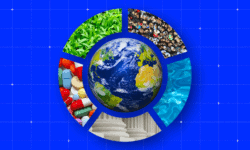Since the COVID-19 pandemic, major companies have faced mounting pressure from consumers, shareholders, and employees to adopt ESG policies into their corporate frameworks. As climate change and working conditions become an increasingly pressing concern, and more countries commit to the renewable energy transition, ESG is proving to be more than a passing trend.
Since the U.S. Securities and Exchange Commission (SEC) began contemplating whether public companies should report on their ESG commitments, with a particular focus on environmental impact, C-suite leaders have taken action. According to a 2024 Deloitte survey, 74% of public companies plan to invest in sustainability reporting technology and tools over the next year.

But while nearly every industry has seen the value, both in operations and market valuation, of embracing an ESG framework, there’s one that’s lagged in adopting environmental, social, governance policies: healthcare. This is partially due to the fact that ESG reporting was voluntary for healthcare leaders in the past—a reality that changed this past March when the SEC passed legislation for companies to standardize climate-related disclosures for investors.
Nonprofit hospitals are constantly questioned by government entities about their tax-exempt status, and embedding ESG principles may help provide validity to their filings. As healthcare leaders have started to learn the importance of ESG—as evidenced by the growing number of “ESG” mentions within the AlphaSense platform for this industry—we explore this budding trend and those who have stepped up to lead change.
Setting the Stage in Healthcare
For healthcare leaders, mandated ESG reporting is less of a distant future and more of a current reality. The U.S. healthcare industry significantly affects both the environment, accounting for between 4.4% and 5.2% of the nation’s total greenhouse gas (GHG) emissions, and socioeconomic health, being the largest source of US jobs and representing 17.3% of gross domestic product. Ultimately, the time to adopt ESG policies is now, as the number of regulatory metrics linked to operational and fiscal performance are rising on multiple fronts.
In 2024, The SEC adopted climate disclosure requirements that require publicly listed providers to report on their greenhouse gas (GHG) emissions and climate risk governance, strategy, risk management, and impacts. As publicly traded companies prioritize efforts within their own organizations and across broader value chains, even healthcare organizations that are not required to submit ESG reporting may feel pressured to do so.
Further, initiatives aimed at measurable ESG improvements in healthcare are emerging. One example is the Joint Commission’s Sustainable Healthcare Certification Program, which became effective in January of 2024. The program aims “to help organizations expand or continue their decarbonization efforts and to receive public recognition of their commitment and achievements in contributing to environmental sustainability.” And if that wasn’t incentive enough for healthcare leaders, some experts predict ESG performance scoring will become a factor in future Medicare payments.
Additionally, the HHS Health Sector Climate Pledge, launched by the Department of Health and Human Services (HHS), is pushing hospitals and other industry stakeholders to cut their GHG emissions by 50% by 2030. Those who follow suit will see the return: stakeholders—including the Joint Commission, insurers, and financial rating agencies—will also expect healthcare organizations to provide information about their ESG efforts in coming quarters.
Europe has already implemented similar criteria, as the Corporate Sustainability Reporting Directive (CSRD) requires companies to disclose on a range of ESG topics focused on governance, sustainability impacts, risks, and targets. It is expected to impact thousands of entities that are not currently required to report on ESG, and it may create reporting obligations for U.S. parent entities with operations in the EU.
Communicating the Framework
While most individual hospitals or health systems already follow ESG principles to some extent, building an ESG framework is the best way to ensure your efforts are being recognized. Ultimately, you want to be able to hold your leadership accountable by setting clear goals and expectations that improve your workplace, output, and operations.
One key aspect of accomplishing this is transparency. How you communicate or share an ESG framework with stakeholders—from patients to lawmakers, donors, regulators, or in the case of public companies, investors—can determine the effectiveness of your organization’s efforts.
“Without the ability to find this information quickly, stakeholders may conclude that healthcare organizations do not have an ESG program or haven’t considered the impact of ESG issues, such as climate change, on their organization,” said Laura Robinette, Partner & Trust Solutions Health Industries Leader at PwC. “This could potentially result in poor ESG ratings and a competitive disadvantage among peers that may be communicating ESG impact in a more effective manner.”
Another important aspect to building an ESG framework is collecting intelligence. Often an inefficient and time-consuming process due to a lack of guidelines surrounding ESG labeling, finding reliable insights means spending hours on potentially fruitless searching across multiple, disparate sources.
Without an AI-based market intelligence platform aggregating all the content sources you need, it’s easy to get caught up in the disparate hunt for the right sources. Check out our infosheet, The Top 4 Market Intelligence Sources for ESG Research, to learn which content sets you need to keep your eyes on and how AlphaSense can make the information gathering and monitoring process easier.
Prioritizing a transparency framework in your efforts will be critical to reaping the benefits of your ESG efforts. By instilling and communicating an effective ESG plan, you will likely:
- Experience greater employee retention and satisfaction
- Attract younger employees who value ESG policies
- Draw the attention of investors who see organizations with high ESG ratings as high-value investment opportunities
- Reduce your carbon footprint on the environment and improve living and health standards in you communities
Healthcare Leaders of ESG
Historically, investment evaluation focused solely on financial returns, but growing concerns around climate change and systemic societal issues and the concept of “triple bottom line” has been gaining traction with investors. Companies that not only acknowledge but actively implement initiatives to address these issues have performed well over the past QoQs. Below are the healthcare leaders pioneering ESG strategy within the space.
Cigna Corporation: Cigna’s ESG risk rating is low (13.0) and ranked highly (21 out of 636 healthcare companies) by Sustainalytics, indicating a well-managed public profile that is free of ESG controversy. They have also focused on promoting healthcare access and affordability. Some of those recent initiatives include:
- Cigna Expanding Small Businesses’ Access to Affordable Health Plans in California
- $5 million grant through the Cigna foundation that will go towards the health and well-being of children
Cigna has been recognized by asset managers globally as a company with a high degree of social responsibility and is included in ESG funds such as the iShares USA ESG Select ETF.

Centenne: Centenne has a low ESG risk rating (15.3) and is ranked highly (51 out of 636 healthcare companies) by Sustainalytics. The care company’s business model has an embedded social focus on bringing services to underrepresented individuals through initiatives, including
- Centene Announces New Community Investments To Address Social Determinants Of Health
- Centene Launches Youth Impact Award for Vaping Prevention
- Centene and Samsung Team up to Enable Virtual Care Options for Underserved Communities
Centenne is also a member of the Bloomberg GenderEquality Index (GEI) which monitors the performance of public companies committed to disclosing their efforts regarding gender equality through policy development, representation, and transparency.

Humana Inc: According to Sustainalytics, Humana holds a low ESG risk rating (18.9) compared to its competitors (116 out of 646 healthcare companies), which, from an ESG investment perspective, shows the company is being well managed to address issues. Through a number of initiatives, Humana has focused on social issues relating to mental health awareness in minority groups, including:
- Humana Foundation Invests 5.4 Million in Eight Communities to Address Social Determinants of Health
- Louisville Nonprofits Receive $2.2 Million through Humana Foundation’s Community Partners Program
- Humana’s 2020 Bold Goal Progress Report Details Improved Mental and Physical Health Among its Population

Keeping Tabs on ESG in Healthcare
With new SEC regulations and corporate ESG initiatives emerging each quarter, staying on top of every development is imperative to staying ahead of your competition in the healthcare space. To do so, you need a tool that aggregates leading industry information, all while helping you cut through irrelevant noise. AlphaSense is that and more.
Using our innovative market intelligence platform, our clients can access broker research, company documents, expert calls, and more from over 10,000 plus content sources–ensuring that they have all the information they need.




